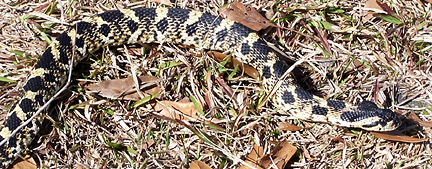
Hey look, a dead snake!
If you happen to chance upon a snake lying with its stomach facing up, and blood spewed over it, you would probably think the snake is dead, right? Well, meet the Hognose snakes, or in particular, the Eastern Hognose Snake (Heterodon platirhinos).

Figure 1: “Eastern Hognose Snake” by Mike Marchand. New Hampshire Fish and Game. URL: http://www.wildlife.state.nh.us/Wildlife/Nongame/snakes/profile_hognose_snake.htm (accessed on 10 Apr 2010)
The Eastern Hognose Snake is commonly known for playing dead as one of its defence mechanisms in the face of danger (Gernot & Hans, 2008). Thanatosis, or playing dead, is not an uncommon defence strategy in the animal kingdom. In fact, thanatosis has been documented for “a great range of animal types, from insects and other arthropods to vertebrates including frogs, reptiles, birds and mammals” (Luis et al., 2010). The concept behind thanatosis is a simple one: by being unresponsive to its predators, the animal appears dead to its predators, which will cause predators to lose interest in the prey. The Eastern Hognose Snake, however, stands out for doing this extremely well and convincingly. When the snake plays dead, it does not simply freeze its body and remain motionless. Instead, the Eastern Hognose Snake also flips belly-up, mouth wide open, oftentimes spewing blood from its mouth, and even releasing an odour as well (Milius, 2006).
.jpg)
Figure 2: “Eastern Hognose Snake playing dead” by Pierson Hill. Amphibians and Reptiles of North Carolina. URL: http://www.herpsofnc.org/herps_of_nc/snakes/Hetpla/Het_pla.html. (accessed on 10 Apr 2013)
However, what is truly amazing is the snake’s persistence in keeping up the performance. If you attempt to turn the snake back to its normal position, it will immediately turn itself belly-up again (Smith, 2010), as can be seen here. Video 1: “Eastern Hognose Snake Playing Dead” by Orry Martin. Orry Martin YouTube Channel, 10 Jul 2011. URL: http://www.youtube.com/watch?v=tuZtKVM6koo (accessed on 10 Apr 2013). However, remaining motionless is surely not enough to deter predators. This is where the second part of its defence come in; presumably, the snake’s foul smelling odour will give the illusion that the snake is not only dead, but also rotting, hence resulting in a two-fold deterrence of predators. So, if you ever see a snake next time that looks or smells dead, think twice again and not get fooled by nature’s greatest actors!
References:
1. Gernot, V. & Hans, K. H. Y. (2008). Death feigning behaviour in three colubrid species of tropical Asia. Russian Journal of Herpetology, 17(1): 15-21.
2. Luis, F. T. et al. (2010). Is it all death feigning? Case in Anurans. Journal of Natural History, 44(31): 1979-1988.
3. Milius, S. (2006). Why play dead? Rethinking what used to be obvious. Science News Online, 170(18): 1-7.
4. Smith, E. N. (2010). Which prey do predators eat? Journal of Creation, 24(2): 75-77.